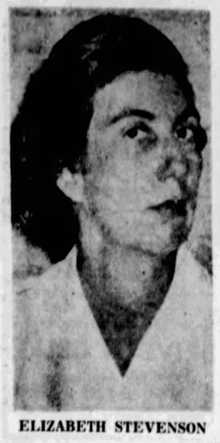Elizabeth Stevenson (academic)
Elizabeth Stevenson (13 June 1919 — 1999) was an American author. In 1956, Stevenson became the first woman recipient of the Bancroft Prize when she won it for her book Henry Adams: A Biography. She was also awarded the Guggenheim Fellowship in 1951 and 1958.
Elizabeth Stevenson | |
|---|---|
 | |
| Born | June 13, 1919 Panama Canal Zone |
| Died | 1999 (aged 79–80) Decatur, Georgia |
| Notable awards | Bancroft Prize (1956), Guggenheim Fellowship (1951 and 1958) |
Early life and education
Stevenson was born on 13 June 1919 in the Panama Canal Zone.[1] She grew up in Great Falls, Montana during her childhood before moving to Atlanta, Georgia with her family.[2] She graduated from Agnes Scott College with a Bachelor of Arts and majoring in English and history.[3]
Career
Stevenson published her first book in 1949 titled The Crooked Corridor; A Study of Henry James. Stevenson's second book was a published biographical work on Henry Adams which won the Bancroft Prize in 1956.[4] Her following books were a collection of Henry Adam's works in 1958[5] and a biography on Lafacadio Hearn in 1961.[6] Additional books that Stevenson wrote include a timeline of the 1920s and an analysis on landscape architecture.[2]
Outside of writing, Stevenson was a member of the War Production Board during the second World War and worked for the Atlanta Public Library in the 1950s.[5] In 1960, she worked at Emory University as a dean's assistant until 1974 when she began teaching American studies.[2] As the first woman faculty member at the Institute for Liberal Arts at Emory University,[7] Stevenson remained at the university until her retirement in 1986 and given the title of emeritus.[8]
Awards and honors
Stevenson was awarded the Guggenheim Fellowship twice in 1951 and 1958.[9] In 1956, Stevenson was the first woman to win the Bancroft Prize with her book Henry Adams: A Biography.[10]
Death
In 1999, Stevenson died in Decatur, Georgia.[8]
References
- Broer, Lawrence R.; Walther, John Daniel, eds. (1990). Dancing Fools and Weary Blues: The Great Escape of the Twenties. Bowling Green State University Popular Press. p. 120. ISBN 0879724579.
- Saunders, Sally (26 July 1979). "Acclaimed biographer Stevenson getting back in touch with her Montana roots". Great Falls Tribune (Great Falls, Montana).
- Rosenberger, Francis Coleman (1973–1974). "Introduction". Records of the Columbia Historical Society, Washington, D.C. 49: xvi–xvii.
- "Elizabeth Stevenson". Wilson Library Bulletin. 31: 300. 1956.
- "Prize-Winning Author Visiting in Great Falls". Great Falls Tribune (Great Falls, Montana). 18 August 1963. p. 21.
- "Books of the Times". Arizona Daily Sun (Tucson, Arizona). 30 July 1961. p. C8.
- "History of the ILA". Emory College of Arts and Literature. Retrieved 20 February 2018.
- "EmoryFindingAids : Elizabeth Stevenson papers, ca. 1950-1999". EmoryFindingAids. Retrieved 20 February 2018.
- "Elizabeth Stevenson". John Simon Guggenheim Memorial Foundation. Retrieved 12 February 2018.
- "Bancroft prize to Elizabeth Stevenson". Library Journal. 111: 1878. 1 September 1986.